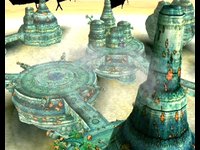|
|

|
PLATFORM
|
PS2
|
BATTLE SYSTEM
|

|
INTERACTION
|

|
ORIGINALITY
|

|
STORY
|

|
MUSIC & SOUND
|

|
VISUALS
|

|
CHALLENGE
|
Unbalanced
|
COMPLETION TIME
|
Less than 20 Hours
|
|
OVERALL

|
- Frustratingly unbalanced enemy encounters.
- Weak action-based combat requiring excessive menu use.
- Terrible environmental graphics.
- Several irritating detours to collect virus cores.
+ Story picks up significantly.
+ Original concept.
|
Click here for scoring definitions
|
|
|
I don't know who said it, but for the sake of argument, let's go with Isaac Newton indirectly stating that whatever goes up must come down. After a very brief improvement in quality with .hack//Mutation, .hack//Outbreak, the third game in the .hack quadrilogy, just falls completely flat. The issues that surfaced occasionally in Mutation have become grossly overbearing, and as a result, .hack//Outbreak is easily the most frustrating game in the series thus far.
This is a sad state of affairs, truthfully, as .hack//Outbreak also features the most interesting plot developments thus far. At the end of .hack//Mutation, the data corruption that was isolated to only a few select areas has spread throughout all of "The World," even infecting the root towns. What's more, the virus has even started to spread outside the game and into the network, affecting the real world in powerful and often dangerous ways. Mia is experiencing some sort of mental breakdown, while Kite and BlackRose set out in an attempt to unite the various powers at play in an effort to quell the encroaching threat. All things considered, .hack//Outbreak has more story packed into its twenty hours of gameplay than either of the previous entries, so it's a bit upsetting to see the frustrations of .hack//Mutation magnified so significantly.
 The root towns used to be the strongest part of the game's visuals. Not anymore.
The root towns used to be the strongest part of the game's visuals. Not anymore.
|
|
The most significant issue with the game is the ridiculous upgrade in difficulty. While .hack//Mutation brought the challenge level to a point that kept the player on his toes, requiring a fair bit of strategy in terms of skill and AI use, .hack//Outbreak simply takes it too far. Enemies have become so strong that some encounters quickly become overwhelmingly frustrating. Spell-users arrive in nearly every encounter, with unfathomable damage levels that can easily wipe out a thousand points of HP in a matter of seconds. Enemies with physical or magic immunities are also incredibly frequent. If it weren't for the arrival of the spells "Pha Repth" and "Phal Repth," which restores all the health of one or more characters, the game would be completely unplayable, and even with them, it very nearly is. Even with these spells, if certain enemies decide to attack in unison, characters are inevitably going to be wiped out. When a character is revived from death, they do so with no SP, which, in the case of a healer, makes them quite useless until their SP is restored. Consumables are even more important than previously.
The culmination of the frustrations throughout .hack//Outbreak arrives with the final boss, who has an attack that can easily kill the player's healer in one blow. All the other battle frustrations from .hack//Infection and .hack//Mutation are present as well, from the pitifully inept AI to the annoying habits of enemy spell-casters to run away. The combat system itself is still a sad excuse for an action RPG, with menu use constantly taking the player out of the action.
The other big issue that permeates Outbreak is the influx of protected areas. Players will recall from the first two games that some areas are locked and need to be opened by using virus cores, which are obtained by having Kite data drain weakened enemies. The first two games had a handful of these, but usually only required two or three cores to open. Generally, the player would have acquired those during the normal course of play and there was little issue. In the latter half of Mutation and all throughout Outbreak, however, the protected areas become far more common, and furthermore require half a dozen or more different cores to open. Players will regularly find themselves having to travel to random areas in completely pointless detours to collect the appropriate cores, a task that quickly (immediately) becomes old.
 Kite and BlackRose must be sick of this crap too.
Kite and BlackRose must be sick of this crap too.
|
|
.hack does, thankfully, continue to do what .hack does best. The unique storytelling method introduced during the first two games continues unabated in volume three. Notably, the news snippets, which were previously little more than an arbitrary look at the invisible real world, play more of a role in the story this time around, providing information on the virus's infection of the network outside "The World."
There's not much to say about the visuals and audio for Outbreak, other than that they are virtually identical to the previous two installations. The character models and designs continue to be excellent while the environments continue to be not so excellent. The voice acting is adequate, but weak in most places, and the soundtrack is enjoyable, though not particularly memorable. Both serve to get the job done, but that's about it.
.hack//Outbreak is both the best and worst game in the quadrilogy thus far. The story it provides easily outpaces the first two games, but at the same time, the already poor gameplay has taken a turn for the worse, and that is a rather astounding feat. By the time Outbreak is over, most players should be looking at a total playtime of roughly fifty hours between the three games, which is quite low and serves to showcase the brevity of the series. Hopefully the final installment can bring things back into line and conclude the series in on a more positive note.
Review Archives
|









